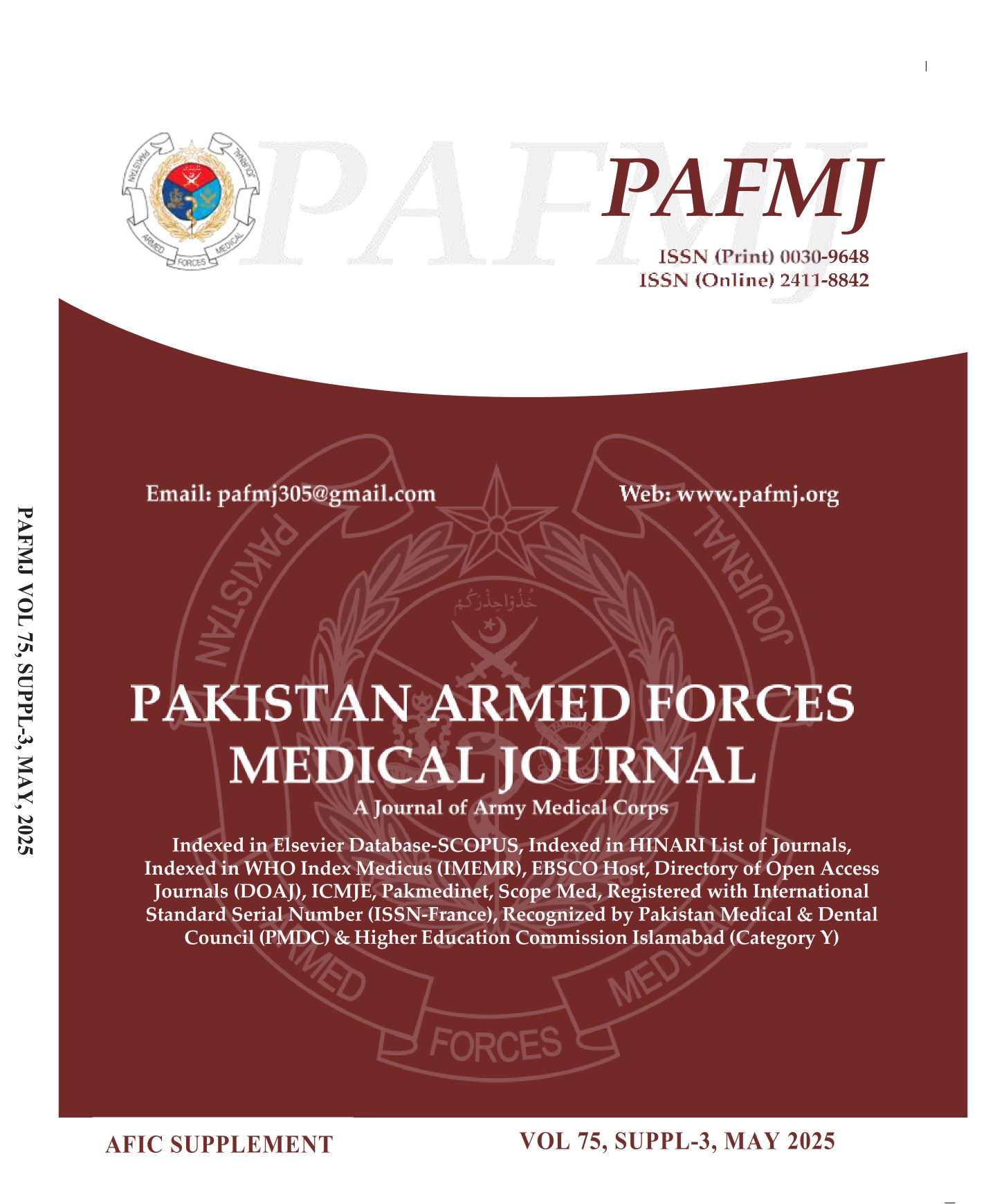Early Clinical Outcomes of Minimally Invasive Cardiac Surgery: A 10-Year Experience
DOI:
https://doi.org/10.51253/pafmj.v75iSUPPL-3.12126Keywords:
Cannulation Technique, Experience, Early Clinical Outcomes, Minimally Invasive Cardiac Surgery, SternotomyAbstract
Objective: To evaluate the early clinical outcome of Minimally Invasive Cardiac Surgery (MICS) - A 10-year experience.
Study Design: Analytical Cross-sectional study.
Place and Duration of Study: Adult Cardiac Surgery Unit, Armed Forces Institute of Cardiology/National Institute of Heart Diseases (AFIC/NIHD), from Jan 1, 2014 to Dec 31, 2023.
Methodology: One hundred and fifty six consecutive patients with isolated aortic valve, mitral valve or tricuspid valve disease and atrial septal defect underwent elective MICS. Operations involving the right and or left atrium were done by right mini-thoracotomy while those of aorta were done by partial mini-sternotomy. Isolated Minimally Invasive Direct Coronary Artery Bypass (MIDCAB) was done via left minithoracotomy. Post-operative complications and 30-day post-op mortality were recorded as early clinical outcomes.
Results: Out of 156 patients, 92(59.0%) were males and 64(41.0%) were females. Median age of the study population was 36(29-48) years. Median ejection fraction was 60(50-60)%. Mean aortic cross-clamp time was 96.72±34.28 min, and median cardiopulmonary bypass (CPB) time was 146(121-176.25) min. Three most common procedures carried out in the series were MVR 59(37.8%), AVR 55(35.3%) and ASD closure 22(14.1%). The total rate of complication was 7.7%, and mortality within 30 days was 3(1.9%). A significant association was found between inotropic duration, ICU stay, ventilation time, and complications such as renal and respiratory failure, with mortality (p<0.05).
Conclusion: As per our experience, different cardiac procedures can be performed via minimally invasive approaches with acceptable and reproducible outcome.
Downloads
References
Chitwood Jr WR. Historical evolution of robot-assisted cardiac surgery: a 25-year journey. Ann. Cardiothorac. Surg 2022; 11(6): 564. https://doi.org/10.21037/acs-2022-rmvs-26
Cerny S, Oosterlinck W, Onan B, Singh S, Segers P, Bolcal C, et al. Robotic cardiac surgery in Europe: status 2020. Front. cardiovasc. Med 2022; 8: 827515.
https://doi.org/10.3389/fcvm.2021.827515
Bonatti J, Wallner S, Crailsheim I, Grabenwöger M, Winkler B. Minimally invasive and robotic coronary artery bypass grafting-a 25-year review. J Thorac Dis 2021; 13(3): 1922.
https://doi.org/10.21037/jtd-20-1535
Seese L, Ashraf SF, Davila A, Coyan G, Joubert K, Zhang D, et al. Robotic totally endoscopic coronary artery bypass grafting-Port placements, internal mammary artery harvesting and anastomosis techniques. J. Vis. Surg 2023; 9.
https://doi.org/10.21037/jovs-22-10
Pike NA, Gundry SR. Robotically assisted cardiac surgery: Minimally invasive techniques to totally endoscopic heart surgery. J Cardiovasc Nurs 2003; 18(5): 382-388.
https://doi.org/10.1097/00005082-200311000-00010
Cohn LH, Chitwood WR, Dralle JG, Emery RW, Esposito RA, Fonger JD, et al. Course guidelines for minimally invasive cardiac surgery. Ann. Thorac. Surg 1998; 66(5): 1850-1851. https://doi.org/10.1016/S0003-4975(98)01162-X
Cerny S, Oosterlinck W, Onan B, Singh S, Segers P, Bolcal C, et al. Robotic cardiac surgery in Europe: status 2020. Front. cardiovasc. Med 2022; 8: 827515.
https://doi.org/10.3389/fcvm.2021.827515
Walther C, Fichtlscherer S, Holubec T, Vasa-Nicotera M, Arsalan M, Walther T. New developments in transcatheter therapy of mitral valve disease. J Thorac Dis 2020; 12(4): 1728.
https://doi.org/10.21037/jtd.2019.12.137
Mihaljevic T, Cohn LH, Unic D, Aranki SF, Couper GS, Byrne JG. One thousand minimally invasive valve operations: early and late results. Ann. Surg 2004; 240(3): 529-534.
https://doi.org/10.1097/01.sla.0000137141.55267.47
Akintoye OO, Adu BG, Otorkpa MJ, Olayode OO, Fodop S, Alemede PO, et al. The current state of minimally invasive cardiac surgery in Africa: a systematic review and meta-analysis. The Cardiothoracic Surgeon 2024; 32(1): 15.
https://doi.org/10.1186/s43057-024-00134-0
Goldstein DJ, Oz MC, editors. Minimally invasive cardiac surgery. Springer Science & Business Media 2003.
https://doi.org/10.1385/1592594166
Coulson AS, Bakhshay S, Bakhshay SA. Influence of minimally invasive cardiac surgery on thoracotomy approach to mitral valve surgery. Int. Surg 1998; 83(1): 91-92.
Chang C, Raza S, Altarabsheh SE, Delozier S, Sharma UM, Zia A, et al. Minimally invasive approaches to surgical aortic valve replacement: a meta-analysis. Ann. Thorac. Surg 2018; 106(6): 1881-1889. https://doi.org/10.1016/j.athoracsur.2018.07.018
Dieberg, G.; Smart, N.A.; King, N. Minimally invasive cardiac surgery: A systematic review and meta-analysis. Int. J. Cardiol 2016; 223; 554-560.
https://doi.org/10.1016/j.ijcard.2016.08.227
Doenst T, Berretta P, Bonaros N, Savini C, Pitsis A, Wilbring M, et al. Aortic cross-clamp time correlates with mortality in the mini-mitral international registry. Eur J Cardiothorac Sur 2023; 63(6): ezad147. https://doi.org/10.1093/ejcts/ezad147
Vo AT, Nguyen DH, Van Hoang S, Le KM, Nguyen TT, Nguyen VL, et al. Learning curve in minimally invasive mitral valve surgery: a single-center experience. J Cardiothorac Sur 2019; 14: 1-9. https://doi.org/10.1186/s13019-019-1038-0
Yadava OP, Casselman F. Conversion in minimally invasive cardiac surgery. Indian J Thorac Cardiovasc Surg 2019; 35(1): 135. https://doi.org/10.1007/s12055-018-0768-2
van der Merwe J, Van Praet F, Stockman B, Degrieck I, Vermeulen Y, Casselman F. Reasons for conversion and adverse intraoperative events in Endoscopic Port Access™ atrioventricular valve surgery and minimally invasive aortic valve surgery. Eur J Cardiothorac Sur 2018; 54(2): 288-293.
https://doi.org/10.1093/ejcts/ezy027
Vollroth M, Seeburger J, Garbade J, Borger MA, Misfeld M, Mohr FW. Conversion rate and contraindications for minimally invasive mitral valve surgery. Ann Cardiothorac Surg 2013; 2(6): 853. https://doi.org/10.3978/j.issn.2225-319x.2013.10.15
Deshpande S,Deshpande P, Deshpande S,Deshpande M, Ahmed I, Panhekar J. Mininmally invasive cardiac surgery - a single centre experience. J Cardiothorac Sur 2015; 10(Suppl-1): A210.
https://doi.org/10.1186/1749-8090-10-S1-A210
Iribarne A, Karpenko A, Russo MJ, Cheema F, Umann T, Oz MC, et al. Eight-year experience with minimally invasive cardiothoracic surgery. World J. Surg 2010; 34: 611-615.
https://doi.org/10.1007/s00268-009-0260-7
White A, Patvardhan C, Falter F. Anesthesia for minimally invasive cardiac surgery. J Thorac Dis 2021; 13(3): 1886.
https://doi.org/10.21037/jtd-20-1804
Lamelas J, Williams RF, Mawad M, LaPietra A. Complications associated with femoral cannulation during minimally invasive cardiac surgery. Ann. Cardiothorac. Surg 2017; 103(6): 1927-1932. https://doi.org/10.1016/j.athoracsur.2016.09.098
Bernstein AD, Parsonnet V. Bedside estimation of risk as an aid for decision-making in cardiac surgery. Ann. Cardiothorac. Surg 2000; 69(3): 823-828.
https://doi.org/10.1016/S0003-4975(99)01424-1
Beckmann A, Meyer R, Lewandowski J, Markewitz A, Blaßfeld D, Böning A. German heart surgery report 2021: the annual updated registry of the German Society for Thoracic and Cardiovascular Surgery. J Thorac Cardiovasc Surg 2022; 70(05): 362-376.
Downloads
Published
Issue
Section
License
Copyright (c) 2025 Muhammad Aamir Khan, Tahseen Ahmed, Muhammad Waseem

This work is licensed under a Creative Commons Attribution-NonCommercial 4.0 International License.















